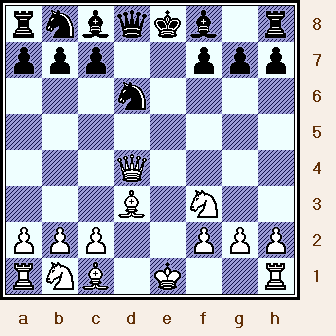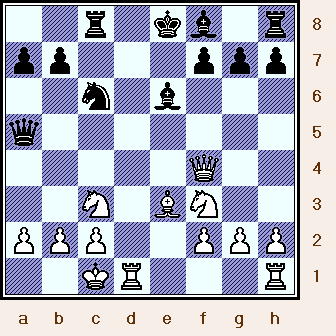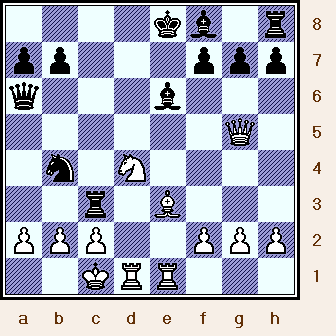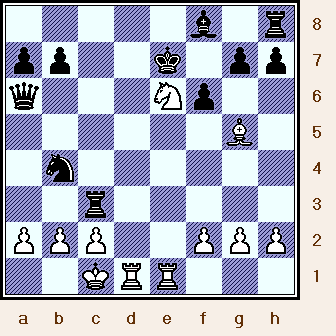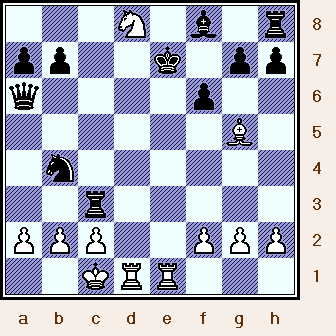All
the |
(Navigation bar
directly below.)
*******
© A.J. Goldsby, 2015.
(All rights reserved.)
****************
Click HERE
to see my
Chess Items.
****************
****************
Buy a book
from Amazon.com
(And help me out as well!)
****************
Click HERE
...
to see a list of the businesses that help to sponsor all of
my chess efforts.
Don't get bunched up.A play at a pun. To truly understand this one, you would have to be familiar with a Jim Varney movie, ["Ernest Saves Christmas"]; where he plays a snake handler. (There appear to be things writhing under a tarp in the back of his truck. He tells the Security Guard - who wants to inspect his vehicle - that there are snakes back there, and sometimes they get tangled or bunched up in knots.) |
Mikhail
Bonch-Osmolovsky (2566) - Boris
Baranov (2545)
|
|
|
When I saw this game on another website, I was impressed enough by it to want to try and annotate this miniature for one of my web pages. (An interesting note was that several searches of the "Mega" database, {and the on-line archive as well}; clearly demonstrated that this exciting miniature is not currently a part of the ChessBase collection of games.)
{The ratings come from the website of respected chess statistician, Jeff Sonas -
see the rating list for January, 1953.}
1.e4 e5; 2.Nf3 Nf6; 3.d4!?,
An older line.
[ The modern continuation is:
3.Nxe5 d6; 4.Nf3 Nxe4;
5.d4,
with a pull for White.
A good, recent example would be:
GM V. Topalov - GM E. Bacrot; /
ICT, XXIII Super-GM
(1/2)
Round # 2 / Morelia, MEX; 2006.
{A long draw.}
[See MCO-14, page # 96, beginning with column # 01 - for
more details on the many variations that can arise from the
move, 3.Nxe5.] ]
3...exd4;
A solid move.
[ Black can also play: 3...Nxe4!?; and should gain equality.
[ See MCO-14, page # 98; and columns # 09 through
column # 11. {And any/all associated notes that go with these lines.} ]
That variation usually proceeds something like:
1.e4, e5; 2.Nf3, Nf6; 3.d4, Nxe4; 4.Bd3, d5; 5.Nxe5,
when White may
have a very small pull here. (Black usually will challenge White's N
on e5 with 5...Nd7.) ]
4.e5 Ne4;
5.Qxd4 d5; 6.exd6 Nxd6; 7.Bd3, {See the diagram,
below.}
A straight-forward developing move, therefore there can be nothing at all wrong with it.
|
|
rnbqkb1r/ppp2ppp/3n4/8/3Q4/3B1N2/PPP2PPP/RNB1K2R b
This would be a good place to take a look at the situation on the board, and try to assess the situation.
[ The main line probably would be:
7.Nc3 Nc6; 8.Qf4 g6!?; 9.Be3 Bg7; 10.0-0-0 0-0; 11.h4 h6;
The end of the column.12.Bc5 Be6; 13.Bb5 a6; 14.Bxc6 bxc6; 15.Bd4, "+/=" ('±')
with a solid edge for White.GM Vassily Ivanchuk - GM Vladimir Akopian; /
Fourth (FIDE) World Championship Tournament (WchT 4th, KO?)
/ Round # 04 / Luzern, Switzerland; 1997. (1-0)
{White won a wild game in a total of forty-one exciting moves.}[ See MCO-14, page # 98; column # 12, and all notes. Please
especially pay attention to the (key) note # (u.) on page # 100. ] ]
7...Qe7+;
(Possibly dubious here.)
After this, Black begins to experience problems with his development, due to his KB being hemmed in.
(Better was >/= 7...Nc6;
in this position for Black.)
8.Be3 Nf5!?;
(Dancing Knight)
Moving this piece for the fourth time ... not a model development.
(However, this move may not be an error - it is the first choice of Fritz 9.0 in this position.)
[ The continuation of:
8...Nc6; 9.Qf4 Be6;
10.Nc3, "+/="
looks like nothing more than a transposition to the MCO line,
(which is also good for White). See the note after Black's 7th
move - above. ]
9.Bxf5 Bxf5;
10.Nc3,
The indicated move, at this point White only has a small edge.
(Fritz 9.0 - "+0.33" after ten minutes.)
[ Also possible here was: 10.Qf4!?, with a very small edge for White. ]
10...Qb4?;
In this game - Black can't seem to keep his hands off his Queen.
This move here is a mistake, and causes a dramatic shift in the box's evaluations of the positions.
(It is also a violation of opening guidelines, as Black moves the Queen again, for the second time in this clash.)
[ Definitely better was:
>/= 10...Nc6;
11.Qf4,
"+/=" {Dg?}
when I played out several lines, but never found anything that
would really scare Black. (Just a solid edge for White, similar
to the continuation given in MCO.)
******************************************************************************
Taking the bait on c2 wasn't wise:
</= 10...Bxc2?; 11.Rc1 Nc6;
12.Qf4, "~"
("+/-") {Diag?}
when Fritz 9 already considers this position to be winning for White.
(After the nearly forced line: 12.Qf4 Nb4; 13.0-0 Bd3; 14.Rfe1
14...0-0-0;
15.Bxa7 Qd6;
16.Qxf7, "/\" +1P Black's game is falling apart. )
]
Now ... should White swap here?
11.Qe5+!,
The correct move, Black's reply here is forced - otherwise the second party drops a piece.
[ Also good for White was:
11.a3,
as after 11...QxQ/d4; 12.Nxd4, '±'
White is clearly better. (But not 11.QxQ/b4?, BxQ/b4; when White
will have little or no advantage at all.)
]
11...Be6;
12.0-0-0 Nc6;
A former Internet student sent me an e-mail, he thought that this move might be a mistake. In actuality, Black is so far behind in the race to get the pieces out, that this move is a good idea - and the first choice of several commercial programs.
[ Even worse would have been:
</= 12...Bd6?; 13.Qxg7,
"+/-" a continuation that the computer
considers winning for a White by three-to-five points here.
*************************************************************************************
Also, a continuation that does not improve the second player's situation
would be:
</= 12...c6?!;
13.Ng5 Qe7; 14.Nxe6 Qxe6;
15.Bg5! Nd7;
Probably forced.
(But not: </= 15...Qxe5??; 16.Rd8#.)
16.Qc7, "+/-" and the threat to pin Black's Queen on the d-file is decisive. ]
13.Qxc7 Rc8;
14.Qf4 Qa5!?; {See the diagram, just
below.}
Black backs away from the exchange of Queens - as he would be a Pawn down with
virtually no compensation at all. (He probably felt that if had to swap Queens here, he may as well offer his resignation.)
|
|
2r1kb1r/pp3ppp/2n1b3/q7/5Q2/2N1BN2/PPP2PPP/2KR3R w
However, the exchange of Queens was probably forced in this position for Black, and the move played only makes a bad situation worse. (The second player is between a rock ... and a hard place here.)
[ >/= 14...Qxf4[]; 15.Bxf4 Bb4; 16.Ne4 0-0; 17.a3, '±' ]
15.Qg5! Qa6;
Black {again} avoids a swap for the same reason as outlined in after Black's last move. (Fritz
suggests the move of 15...Bb4 here for Black.)
16.Rhe1 Nb4;
I don't think it really matters here what move Black plays in this situation, after 16...h6; 17.Qg3, the second player has no decent moves left to him.
17.Nd4! Rxc3!?;
(Pure desperation.) {See
the diagram below.}
Now this wild try at a swindle is just a mistake, ('?'); but it redeems a game of otherwise little value, by allowing the first player a chance at a scintillating mating combination.
|
|
4kb1r/pp3ppp/q3b3/6Q1/1n1N4/2r1B3/PPP2PPP/2KRR3 w
A curious situation. Do you take the Rook, or is there something better here for White?
[ The move of:
>/= 17...f6[];
was forced for Black, the second party is still quite lost,
but at least poor Baranov would have avoided being checkmated here.
]
Now its "White to move and win." Are you up to the challenge here?
18.Qd8+!! Kxd8; 19.Nxe6+ Ke7;
This is actually the best defense. (19...Kc8?!; is
met by 20.Rd8#.)
[ Or 19...Ke8; 20.Nxg7+! Bxg7; 21.Bg5+!, and mate on d8 next. ]
20.Bg5+ f6[];
{See the diagram, just below.}
This is forced, if the King retreats, Rd8# is the simple answer.
|
|
5b1r/pp2k1pp/q3Np2/6B1/1n6/2r5/PPP2PPP/2KRR3 w
Please take a look at this, this ... "fine kettle of fish."
Now it appears that Black might be getting way here. Is this correct?
21.Nd8+!, "+/-"
Black Resigns. {See the diagram, just below.}
|
|
Nope! This piquant Knight move - which cuts off Black's sole escape square for the King - is the answer. Baranov throws in the towel, after he plays "give-away" (on e2, and then on e3), it will be a rare mate in the middle of the board.
A good game to study to sharpen your tactics. (Cute Queen sack.)
Copyright (c) A.J. Goldsby, 2006. All rights reserved.
1 - 0
The analysis for this page was prepared with the excellent programs, ChessBase 8.0 and ChessBase 9.0.
The HTML was polished with several different tools and programs, (mostly FP) ... the text was checked for spelling with MS Word.
The diagrams were created with the program, Chess Captor 2.25.
Click HERE to - go to or return - to my HOME PAGE ... for this site.
Click HERE to go (or return) to my site map (page).
Click HERE to go to my "Annotated Games II" (page).
Click HERE
to go (or return) to my {2nd}
main page on miniatures / or "Best Short Games," (Vol.
IV.)
(Or you could use the "Back
Button" on your web browser.)
Copyright (c) LM A.J. Goldsby I
Copyright (©) A.J. Goldsby, 2011. All rights reserved.
*******
This page was created in May, 2006. It was posted: 05/11/2006. It was last updated on: July 14, 2012 02:16 AM .
